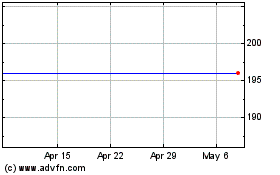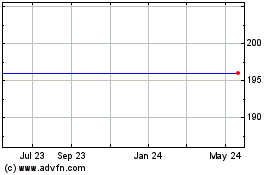LinkedIn Co-Founder Reid Hoffman Calls Microsoft Deal a 'Re-Founding Moment'
June 13 2016 - 4:59PM
Dow Jones News
By Deepa Seetharaman
For LinkedIn Corp. and its co-founder and Executive Chairman
Reid Hoffman, the sale to Microsoft Corp. announced Monday puts a
positive cap on what's been a rocky stretch.
Since Mr. Hoffman launched the professional social-network from
his living room in 2003, it has grown to have 105 million monthly
users and $3 billion in annual revenue. But it also has struggled
to harness its rich and powerful trove of data effectively, and its
share price plunged more than half earlier this year after it
delivered a less-robust-than-expected earnings outlook.
The $26.2 billion in cash that Microsoft is paying for LinkedIn,
at a 50% premium to Friday's closing price, gets LinkedIn's value
back to slightly above where it was before that plunge. And
according to LinkedIn Chief Executive Jeff Weiner, it places the
professional network among other giants of the tech industry.
Mr. Hoffman, who owned 11% of LinkedIn's shares and held 53% of
its voting power as of last year, said Monday he backs the deal.
"Today is a re-founding moment for LinkedIn," he said. "I see
incredible opportunity for our members and customers and look
forward to supporting this new and combined business." LinkedIn
said Mr. Hoffman would continue to be involved informally in the
Microsoft-owned LinkedIn.
Mr. Hoffman, a former Apple Inc. and PayPal executive who also
is a partner at venture-capital firm Greylock Partners, started 13
years ago inviting 350 of his contacts to join LinkedIn and create
their own profiles. By the end of the month, the service had 4,500
members.
In a 2009 interview with The Wall Street Journal, Mr. Hoffman
said he used the money from PayPal to create LinkedIn. He already
invested in social networking companies like Facebook Inc.
"People will be discovering that the internet helps their
career," he said at the time.
LinkedIn shuffled its executive ranks a few times, eventually
hiring Mr. Weiner first as interim president in December 2008 and
later as CEO. It went public in 2011, when closing its first day of
trading with a market value of $9.1 billion. The offering was
controversial, with many observers saying investors were overly
exuberant about a company that generated a profit of just $15.4
million the previous year.
Proponents lauded LinkedIn's fast-growing subscriber base and
diversified revenue streams -- a rarity among web companies, many
of which rely almost entirely on advertising to power revenue.
About two-thirds of LinkedIn's revenue comes from its
talent-solutions division, which helps corporate recruiters
identify job candidates. It also generates cash from premium
subscriptions and advertising.
It also is one of few U.S. internet companies with a presence in
China, where LinkedIn has launched Chitu, a networking app for
Chinese professionals. Executives also have said they would like to
develop products tailored to the Indian market, LinkedIn's
second-largest market outside the U.S.
But LinkedIn struggled to adapt to the mobile revolution, one
that has greatly benefited Facebook. Last year, it overhauled its
mobile app -- and there are signs that it's gaining traction.
LinkedIn is installed in fewer phones than heavily used apps
like Facebook, Snapchat, Twitter Inc. and Instagram, but unlike
those four, users spent more time on the LinkedIn app in the first
quarter of 2016 compared to the year-ago period, according to
digital data firm SimilarWeb.
LinkedIn is the 28th most-visited website in the world and the
14th most popular in the U.S., says SimilarWeb. About one-third of
LinkedIn's traffic comes from the U.S. where users spend an average
of five minutes and 16 seconds a day in the app.
Still, its ad growth has been slowing, which is what spooked
investors. Earlier this year, the company projected revenue in 2016
would grow roughly 22% -- down from 35% in 2015. It later boosted
its outlook, but revenue growth still looks poised to fall far
short of 2015.
Executives also backtracked on its advertising strategy,
deciding to double-down on native advertising and shelving an ad
product that it launched less than a year prior. LinkedIn
executives also said they faced economic pressure overseas and a
slowdown in its higher-margin online sales business.
Several analysts downgraded the stock earlier this year. But
last week, RBC Capital Markets analyst Mark Mahaney upgraded
LinkedIn, citing his survey of 290 U.S. recruiters, which found 45%
of them would spend more on LinkedIn over the next 12 months and
48% would maintain their spending.
Write to Deepa Seetharaman at Deepa.Seetharaman@wsj.com
(END) Dow Jones Newswires
June 13, 2016 16:44 ET (20:44 GMT)
Copyright (c) 2016 Dow Jones & Company, Inc.
Linkedin Corp. Class A (NYSE:LNKD)
Historical Stock Chart
From Jun 2024 to Jul 2024

Linkedin Corp. Class A (NYSE:LNKD)
Historical Stock Chart
From Jul 2023 to Jul 2024
